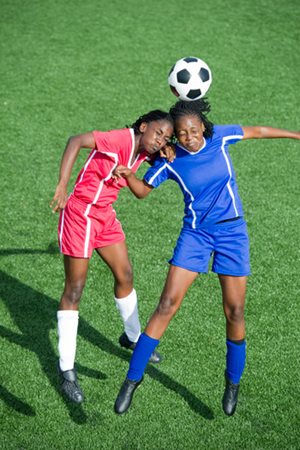 Overview
Overview
A concussion is an injury to the brain. It caused by a traumatic force to the brain, which may be a direct hit or just a sudden change in direction without a hit. This can cause damage to brain cells. Loss of consciousness (passing out) is not required for a concussion. Concussions may happen in many sports. In high school, the highest-risk sport is football, but concussions can occur in any sport.
It is very important to recognize concussions when they happen, and to remove the athlete from play immediately. Returning to play too soon, before the brain is fully recovered, can be very risky. The long term effects of concussion are not yet fully understood.
Symptoms
Concussion symptoms are varied and not always obvious. They may appear right away or after some time. Some signs/symptoms include:
- Headache
- Nausea or vomiting
- Dizziness
- Blurry vision
- Low energy
- Sleepiness
- Excess emotion
- Difficulty thinking or concentrating
- Appearing dazed or confused
Assessment
Your child’s doctor will ask questions about the injury, as well as what happened afterwards. He or she will also ask whether your child has had concussions before. It is very important to tell your doctor if this is not the first concussion.
Your doctor may test balance, coordination, vision, and memory to assess the brain's ability to function normally. Many times, other tests are not needed. Sometimes your doctor may order a CT or MRI scan.
Some teams also use computerized testing to measure an athlete’s mental performance after a hit. This test result can be compared to pre-season test results, when available, to see if there is a difference.
Treatment
The most important part of concussion treatment is rest. This includes brain rest as well as physical rest. Your child will slowly return to normal activities when symptoms are better. Some activities that require concentration may make symptoms worse—this includes homework, video games, and reading. Improvement in younger athletes may take a couple of weeks or more.
Return to Play
Returning to play after concussion must be a slow, steady process. The athlete must first be completely without symptoms, both during rest and with normal daily activities. He or she then may start a slow, step-wise return to activity. The athlete must be symptom-free at each step before going on to the next one.
Returning to play before the brain has healed can have dangerous consequences. A second hit to an injured brain can cause long-term damage, and in some cases, death.
It is recommended that a young athlete with a concussion is seen and cleared by a doctor, with training in concussion management, before returning to sports.
Prevention
Proper equipment should be worn, and safe technique and rules should be followed. However, no rule or equipment is concussion-proof. Coaches, trainers, and parents should know about the signs of concussion. They should recognize signs of concussions and remove athletes when a concussion is suspected.
More Information
Page QR Code:

Q: What is a concussion?
A concussion is an injury to the brain’s functioning caused by a traumatic force to the brain. This can be a bump or a hit to the brain that can damage the brain cells.
Q: My child didn’t pass out—does that mean s/he doesn’t have a concussion?
No. A concussion does not require a loss of consciousness.
Q: My child doesn’t play football—is s/he still at risk for concussion?
Yes. Many sports carry the risk of concussion, especially contact sports.
Q: My child had a hard hit—how do I know if s/he has a concussion?
There are many possible symptoms, and they may occur right away or much later. Be on the lookout for: headache, nausea/vomiting, dizziness, blurry vision, fatigue, drowsiness, excess emotion, difficulty thinking or concentrating, or any odd or unusual behavior.
I think my child may have a concussion—what should I do?
If s/he is playing in a game, remove him/her immediately. Then, call your doctor and arrange for an evaluation.
Q: How is this diagnosed?
Your child’s doctor will ask detailed questions about the injury, as well as what happened afterwards. He or she will also ask whether your child has had prior concussions—it is very important to tell your doctor if this is not the first concussion. The doctor will do a neurologic evaluation, and may test balance, coordination, vision, and memory.
Q: Will my child get xrays or other imaging?
In general, imaging is not used, but if your doctor suspects a structural injury, he or she may order a CT or MRI scan.
Q: How is concussion treated?
The essential cornerstone of concussion treatment is rest. This includes cognitive rest as well as physical rest. Nothing requiring concentration should be done—this includes homework, video games, and reading. Recovery may take a couple of weeks or more. Your child may need extra time to complete assignments or take tests after they are allowed back in school.
Q: When can my child go back to sports?
Returning to play after concussion must be a gradual process. The athlete must first be completely without symptoms at rest, and then may start a slow, progressive, step-wise return to activity. The athlete must be symptom-free at each step before progressing to the next one.
Baseline: Back to school with regular school activities
Step 1: Light aerobic activity
Step 2: Moderate activity
Step 3: Heavy, non-contact activity
Step 4: Practice and full contact
Step 5: Competition
Q: What if my child wants to return to sports early?
This is not recommended. Returning to play before the brain has healed can have devastating consequences. A second hit to an injured brain can cause long-term damage, and in some cases, death.
It is recommended that a young athlete with a concussion should be seen and cleared by a doctor (with training in concussion management) before returning to sports.

 POSNA.org
POSNA.org
 Overview
Overview